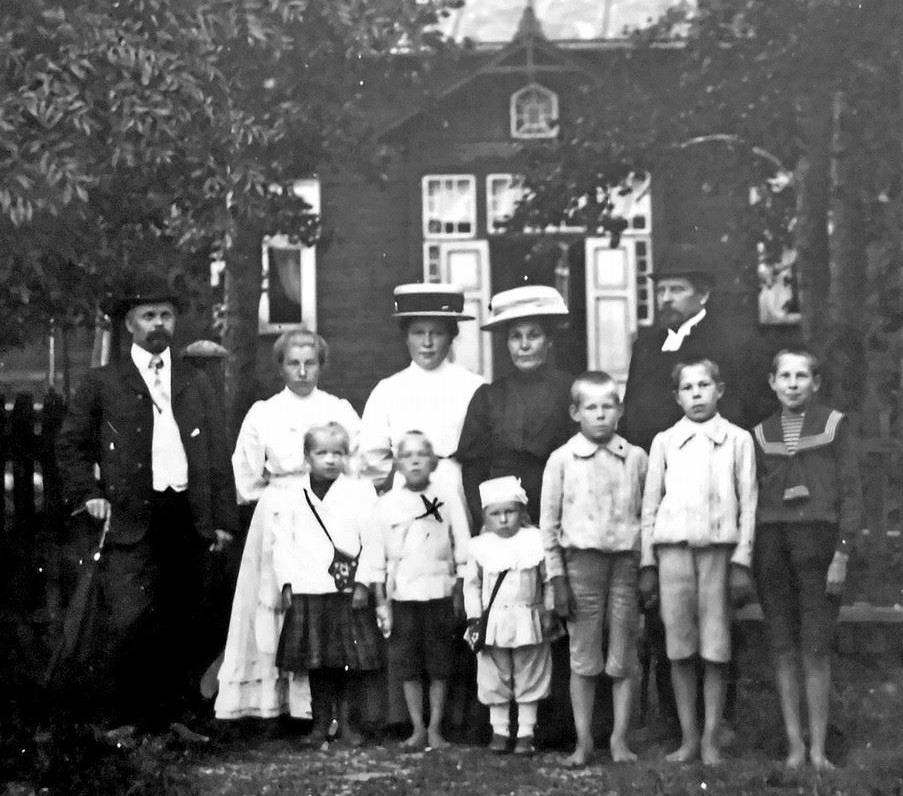
Finnish Families: The Uoti Family (1910)

Figure 1.--This Finnish family portrait was taken in 1910. They are the family of a pastor taken in front of his vicarage. The church was located in Piikki�, western Finland. In the back row, left to right, we can see: the church organist Salmela, the family servant Edla, Mrs. Elina Kupila (that had some charge in the congregation), the Pastor's wife Augusta Laurilan, and the Pastor Juho Uoti. The ladies' hars seem to be a sratus symbol. The servant does not have one. In the front row: the organist's daughther Oiva Lahja, and the five children of the Pastor: Arvo Insar, Jalo Aarre, Kauko Johannes and Ensio Ilmari. The children look to be about 3-13 years old. The boys wear blouses and knee pants without hosiery and shoes. The older boy wears a sailor suit. The todler boy is dressed differently, wearing a tunic outfit. We are not sure why. Perhaps it is more protective such as warmer clothes and shoes. But we see other family images with toddlers dressed more like the older boys here. The girl here wears shoes, but Finnish girls also wnt barefoot like the boys. We think it was somewhat more common for girls to wear shoes when dressing up.
|
|
This Finnish family portrait was taken in 1910. They are the family of a pastor taken in front of his vicarage. The church was located in Piikki�, western Finland. In the back row, left to right, we can see: the church organist Salmela, the family servant Edla, Mrs. Elina Kupila (that had some charge in the congregation), the Pastor's wife Augusta Laurilan (maiden name), and the Pastor Juho Uoti. The ladies' hart seem to be a status symbol. The servant does not have one. In the front row: the organist's daughther Oiva Lahja, and the five children of the Pastor: Arvo Insar, Jalo Aarre, Kauko Johannes and Ensio Ilmari. The children look to be about 3-13 years old. The boys wear blouses and knee pants with hisiery and shoes. The older boy wears a sailor suit which we believe would have been seen as a formal garment. The todler boy is dressed differently, wearing a tunic outfit. We are not sure why. Perhaps it is more protective such as warmer clothes and shoes. But we see other family images with toddlers dressed more like the older boys here. A reader writes, "In Finland children went often barefoot in summertime. Really I don't understand why the younger child is shod when all his siblings are barefoot, even the elder brother wearing a sailor suit that looks quite formal." The girl here wears shoes, but Finnish girls also went barefoot like the boys. We think it was somewhat more common for girls to wear shoes when dressing up.
HBC

Related Chronolgy Pages in the Boys' Historical Web Site
[The 1880s]
[The 1890s]
[The 1900s]
[The 1910s]
[The 1920s]
[The 1930s]
[The 1940s]
[The 1930s]
[The 1940s]
[The 1950s]
[The 1960s]
[The 1970s]
[The 1980s]
Related Style Pages in the Boys' Historical Web Site
[Long pants suits]
[Knicker suits]
[Short pants suits]
[Socks]
[Eton suits]
[Jacket and trousers]
[Blazer]
[School sandals]
[School smocks]
[Sailor suits]
[Pinafores]
[Long stockings]
Navigate the Boys' Historical Clothing Web Page
[Return to the Main Finnish 1910s family page]
[Return to the Main Finnish family page]
[Return to the Main Finnish page]
[Return to the Main family country page]
[Introduction]
[Activities]
[Biographies]
[Chronology]
[Clothing styles]
[Countries]
[Bibliographies]
[Contributions]
[FAQs]
[Glossaries]
[Images]
[Links]
[Registration]
[Tools]
[Boys' Clothing Home]
Created: 6:36 PM 9/5/2018
Last updated: 9:06 PM 9/5/2018



